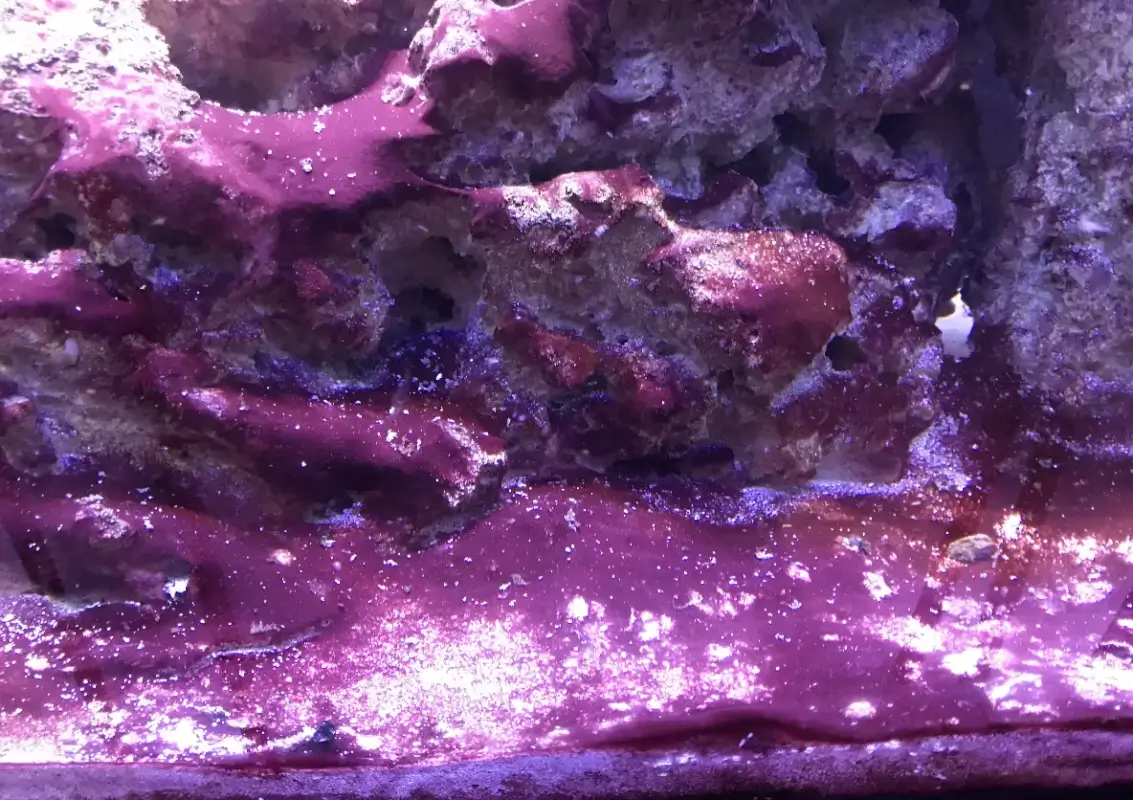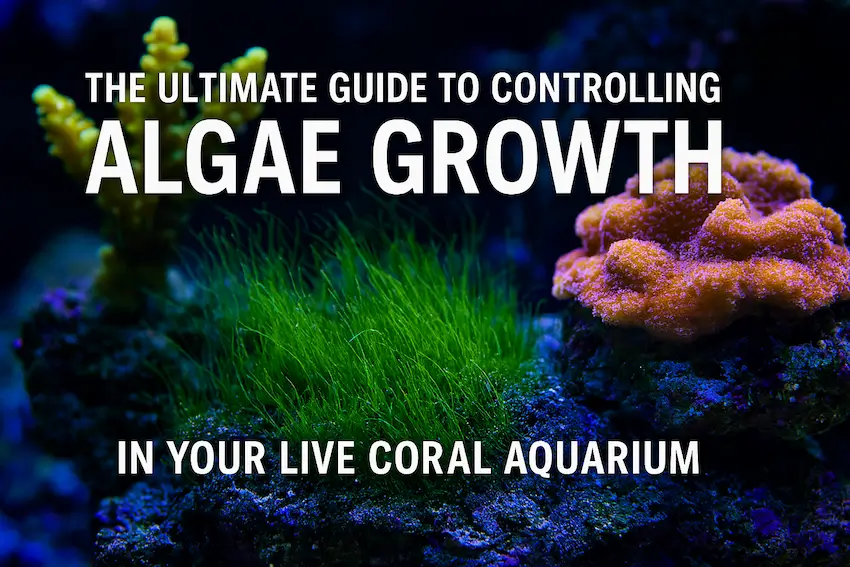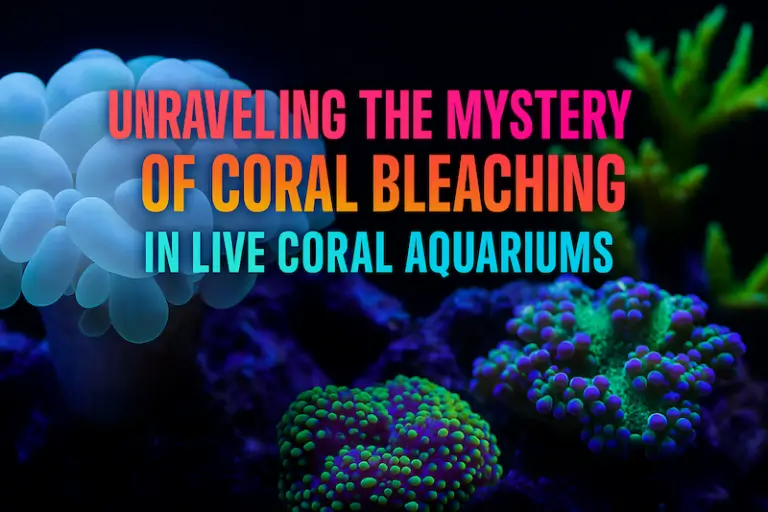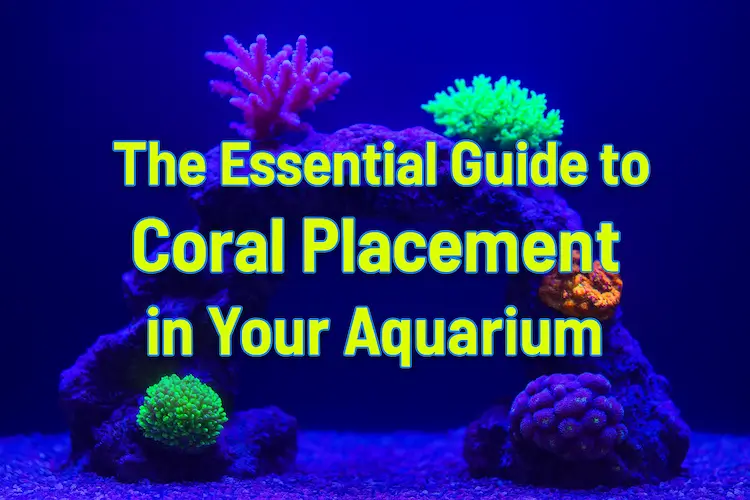Your Ultimate Guide to Controlling Algae Growth in Your Live Coral Reef
Introduction
Algae growth is a common issue that many live coral aquarium enthusiasts face. While algae can be beneficial in small amounts, excessive growth can negatively impact the health and appearance of your corals. In this comprehensive guide, we will explore the different types of algae that can plague your aquarium and provide practical tips on how to control and prevent their growth.
Types of Algae in Live Coral Aquariums
1. Green Algae

Green algae are among the most common types of algae found in aquariums. They can quickly cover rocks, glass, and decorations, giving the tank a dirty and unsightly appearance. Green algae thrive in the presence of excess nutrients, such as nitrates and phosphates, and prolonged exposure to light.
2. Brown Algae
(Diatoms)

Brown algae, also known as diatoms, typically appear in new aquarium setups. They form brown patches on substrate, rocks, and decorations. Diatoms feed on silicates present in the water and can be controlled by addressing the source of silicate contamination.
3. Red Algae
(Cyanobacteria)

Red algae, or cyanobacteria, are a type of bacteria that form slimy, reddish-brown mats in the aquarium. Cyanobacteria thrive in low-oxygen environments and can indicate poor water quality. Physical removal and improving water circulation are essential in combating red algae outbreaks.
Controlling Algae Growth
1. Monitor Water Parameters
Regularly test and monitor water parameters, including nitrates, phosphates, silicates, and pH levels. Maintaining optimal water quality can help prevent algae from taking hold in your aquarium.
2. Implement Proper Lighting
Adjust the duration and intensity of lighting to discourage algae growth. Consider using a timer to regulate the light cycle and mimic natural daylight conditions for your corals.
Learn More: Dim or Bright, Your Guide To Reef Light
3. Maintain a Balanced Nutrient Level
Keep a check on nutrient levels in the aquarium by feeding your fish sparingly and performing regular water changes. Overfeeding can lead to excess nutrients in the water, fueling algae growth.
4. Introduce Algae-Eating Creatures
Add algae-eating organisms, such as hermit crabs, snails, or algae-eating fish, to help control algae growth naturally. These creatures can graze on algae, keeping it in check and promoting a cleaner aquarium environment.
5. Use Chemical Algae Inhibitors Sparingly
While chemical algae inhibitors can be effective in controlling algae outbreaks, they should be used as a last resort. Over-reliance on chemicals can disrupt the aquarium’s ecological balance and harm beneficial microorganisms.
Preventing Algae Regrowth
1. Regular Maintenance
Establish a routine maintenance schedule that includes cleaning the aquarium glass, siphoning debris from the substrate, and pruning overgrown plants. Removing excess organic matter can help prevent algae regrowth.
Related Article: Saltwater Aquarium Maintenance Checklist: A Comprehensive Guide
2. Optimise Filtration System
Ensure that your aquarium’s filtration system is adequate for the tank size and bioload. A well-functioning filtration system can remove debris and waste, preventing the accumulation of nutrients that algae feed on.
Related Articles:
- How to Choose the Right Filter for Your Aquarium
- Chemical Filtration Media Explained: Enhancing Water Quality in Your Reef Tank
3. Quarantine New Additions
Before adding new corals, fish, or live rock to your aquarium, quarantine them separately to prevent introducing algae or pests. Inspect new additions for signs of algae growth or disease before introducing them into your main display tank.
Related Article: Setting Up a Quarantine Tank: Why and How…
🌊 Ideal Water Parameters For Your Reef
Creating a stable, clean, and nutrient-balanced marine environment is crucial for coral growth, vibrant coloration, and the long-term health of your reef tank inhabitants. Here’s a breakdown of the optimal water parameters you should aim for, including both macro and micro-elements, trace metals, and biological balance indicators.
🧪 Major Elements
| Parameter | Ideal Range | Notes |
|---|---|---|
| Salinity | 1.025 – 1.026 SG (35 PPT) | Measured with a refractometer or hydrometer. Stability is key. |
| Temperature | 24 – 26°C (75 – 78°F) | Avoid fluctuations—use a heater and fan/chiller if needed. |
| Calcium (Ca) | 400 – 450 ppm | Essential for coral skeleton growth. |
| Alkalinity (dKH) | 8 – 12 dKH | Helps maintain stable pH. Avoid rapid changes. |
| Magnesium (Mg) | 1300 – 1450 ppm | Supports calcium absorption and coral calcification. |
🔬 Minor Elements & Nutrients
| Parameter | Ideal Range | Notes |
|---|---|---|
| Nitrate (NO₃) | 1 – 5 ppm | Too high encourages algae; too low can starve corals. |
| Phosphate (PO₄) | 0.01 – 0.05 ppm | Necessary in trace amounts; keep low to avoid algae outbreaks. |
| Ammonia (NH₃/NH₄⁺) | 0 ppm | Should always be undetectable in a mature reef tank. |
| Nitrite (NO₂) | 0 ppm | Also should be undetectable. Indicates immature biological filtration if present. |
⚗️ Trace Elements (Metals & Halogens)
These are needed in minute amounts but are vital for coral color, enzyme function, and growth.
| Trace Element | Recommended Level | Function |
|---|---|---|
| Strontium (Sr) | 8 – 10 ppm | Supports skeletal development. |
| Iodine (I) | 0.04 – 0.06 ppm | Enhances soft coral health and coloration. |
| Potassium (K) | 380 – 420 ppm | Important for coral pigmentation. |
| Iron (Fe) | 0.002 – 0.01 ppm | Helps zooxanthellae photosynthesis. |
| Manganese (Mn) | Trace (dosed as needed) | Involved in coral enzyme activity. |
| Boron (B) | 4 – 6 ppm | Aids alkalinity stability and coral resilience. |
| Fluoride (F) | Trace (within sea salt mix) | Strengthens coral skeletons. |
🔁 Other Key Parameters
| Parameter | Ideal Range | Notes |
|---|---|---|
| pH | 8.1 – 8.4 | Should remain stable—fluctuations stress coral. |
| ORP (Redox) | 300 – 450 mV | Indicates water cleanliness; too low can indicate organic buildup. |
| Silicates (SiO₂) | < 0.5 ppm | High levels encourage diatoms. |
| Dissolved Oxygen | 6 – 8 ppm | Ensure good water flow and surface agitation. |
🧼 Tip: Test, Track, and Adjust
- Use high-quality test kits or digital testers for accuracy.
- Keep a log to monitor long-term trends.
- Dose trace elements cautiously—more isn’t always better.
- Conduct regular 10–20% water changes to replenish depleted elements.
📌 Pro Tip: Many high-quality reef salts come pre-mixed with the right balance of trace elements and halogens. Always research what your specific corals require and tailor your dosing schedule accordingly.
Conclusion
By following these tips and strategies, you can effectively control algae growth in your live coral aquarium and create a thriving ecosystem for your aquatic pets. Remember that maintaining a healthy balance of nutrients, lighting, and algae-eating creatures is key to preserving the beauty of your coral reef habitat. With proper care and vigilance, you can enjoy a vibrant and algae-free aquarium teeming with life.








